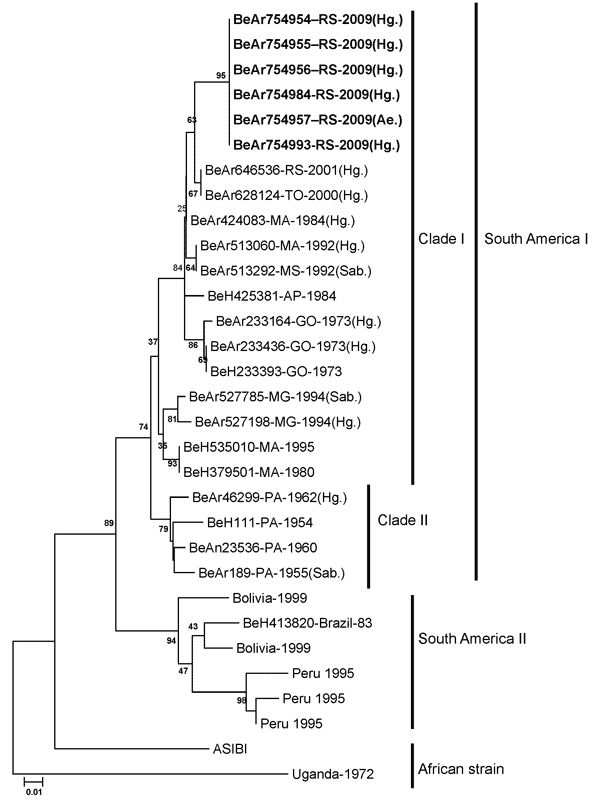Yellow Fever Virus in Haemagogus leucocelaenus and Aedes serratus Mosquitoes, Southern Brazil, 2008
Jáder da C. Cardoso, Marco A.B. de Almeida, Edmilson dos Santos, Daltro F. da Fonseca, Maria A.M. Sallum, Carlos A. Noll, Hamilton A. de O. Monteiro, Ana C.R. Cruz, Valéria L. Carvalho, Eliana V. Pinto, Francisco C. Castro, Joaquim P. Nunes Neto, Maria N.O. Segura, and Pedro F.C. Vasconcelos

Author affiliations: Author affiliations: Secretaria da Saúde do Estado do Rio Grande do Sul, Porto Alegre, Brazil (J. da C. Cardoso, M.A.B. de Almeida, E. dos Santos, D.F. da Fonseca, C.A. Noll); Universidade de São Paulo, São Paulo, Brazil (J. da C. Cardoso, M.A.M. Sallum); Instituto Evandro Chagas, Ananindeua, Brazil (H.A. de O. Monteiro, A.C.R. Cruz, V.L. Carvalho, E.V. Pinto, F.C. Castro, J.P. Nunes Neto, M.N.O. Seguara, P.F.C. Vasconcelos); Universidade do Estado do Pará, Belém, Brazil (P.F.C. Vasconcelos)
Main Article
Figure 2

Figure 2. Phylogenetic analysis of partial (1,205 nt) structural region of the envelope gene of 6 yellow fever virus (YVF) isolates (boldface) sequenced from samples recovered from hematophagous arthopods collected in Rio Grande do Sul State, southern Brazil, November 2008. Comparison is shown with sequences of 17 genotype I YFV strains from Brazil and with sequences of 6 reference strains of genotype II from South America (Peru, Bolivia, and Brazil) obtained from GenBank. The analysis was performed by the neighbor-joining method; the nucleotide distance was calculated by the Kimura 2-parameter method. Bootstrap values were calculated after 1,000 replicates and are listed only in the main branches. The sequences of YFV strain Asibi and Uganda were used as outgroups. Scale bar indicates a divergence of 10%.
Main Article
Page created: August 29, 2011
Page updated: August 29, 2011
Page reviewed: August 29, 2011
The conclusions, findings, and opinions expressed by authors contributing to this journal do not necessarily reflect the official position of the U.S. Department of Health and Human Services, the Public Health Service, the Centers for Disease Control and Prevention, or the authors' affiliated institutions. Use of trade names is for identification only and does not imply endorsement by any of the groups named above.
